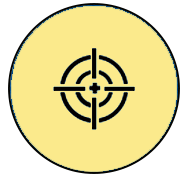
Flapping Bird Type – 2
 Objective
Objective
To help teachers in creating a puppet of a flapping bird for story-telling and other purposes.
Estimated time to create the flapping bird type 2
30 to 45 minutes
Materials required for creating flapping bird type 2
- 2 A4-coloured papers (different colours for wings and body)
- Glue stick or fevicol
- Scissors
- Googly eyes
- Bamboo skewer
Preparation for activity
- Use A4-coloured papers (80-100 gsm) for durability and smooth movement.
- Keep scissors, glue, pencil, and skewers ready in advance.
- Make one model and check the flapping action before preparing for class use.
- If you are using hot glue instead of Fevicol, ensure that the hot glue is heated suitably and is ready for use.
- Use child-safe scissors, if children are involved.
Procedure
- Prepare the Bird’s Body and wings
- Fold a paper lengthwise and draw a bird shape (with head and tail).
- Cut it out to get the full bird body.
- Add another paper layer for thickness if needed.
- Fold another paper and draw scalloped wing shapes and tail. Cut it along the lines. Set them aside.
- Fix the bamboo skewer
- Place one end of the bamboo skew stick, in between the two paper pieces cut out for the body and glue all of them together.
- Fix the wings and eyes
- Stick the wings to the back side of the body at equal height on both sides. Also stick the tail of the bird. Fix the googly eyes for the bird.
- Paper strip mechanism
- Cut the coloured paper for about 2–3 cm wide. Roll and glue to secure the end to get a thick strip. Make a couple of strips like this.
- Apply fevicol on one end of the strip. Stick this end to the bottom side of the wing. This will act as the pulling strip for flapping the wings.
- Fix the strip to the other wing as well.
- Create the Paper Pipe
- Roll a piece of paper tightly around a pencil/finger to make a paper tube.
- Glue the end securely. Let it dry well.
- Assemble the Flapping Mechanism
- Insert the skewer into the paper pipe.
- Attach the extended strip from the bird to the pipe. Trim the strip beyond the pipe, if necessary. Allow the glue to dry.
- As the paper tube moves up and down, it lifts and lowers the strip, causing the wings to flap.
- Use marker pens to add details like feathers or beak.
- Decorate if desired, but keep it lightweight.
Step by Step Pictures to create the puppet










Important Tips
- Wings should be even and symmetrical for proper flapping.
- Make sharp folds for better structure.
- Add a small tape layer to the moving end of the strip, to avoid tearing.
- Wings should be symmetrical and glued at the same level.
- Keep sufficient length of the pulling strip so the wings can flap without resistance.
- Ensure the paper pipe is cylindrical and not too tight around the stick.
- Test the flapping before class, to avoid glitches during demonstration.
- While creating the puppet, replicate the character illustration given in the children’s textbook. Once the puppet is ready, use the character’s name from the textbook. Using the name in the textbook helps children to remember the content.
- The teacher should use the puppet at an appropriate time. The teacher can narrate the story in a humorous manner. The teacher may make intentional mistakes to encourage children to correct them, thereby helping them become more actively engaged.
Precautions
- Always keep the face of the puppet towards the audience.
- Focus of the Puppet Master should be on the puppet.
- One the puppets that are talking, should be activated. Other puppets should remain in a still position.
Troubleshooting:
- If the wings are not flapping, check if the pulling strip is too tight or too loose. Adjust strip tension; check pipe’s fit.
- If the paper is tearing, avoid pulling too hard; reinforce joints with tape.
- If the pipe slips from position, use glue and press well while drying to secure properly.
- If the flapping is unbalanced, check if both wings are of the same size and shape.
 Notes to the Teacher
Notes to the Teacher
- Puppets can be used to demonstrate bird movement, air resistance or storytelling.
- Let the students try gently pulling the strips to observe motion.
- Allow students to make their own birds in pairs or groups for better engagement.
- Hang or place puppets on the wall after the activity to reinforce learning visually.
- Using puppets also aids in developing motor skills, such as hand-eye coordination. Additionally, puppets can enhance communication and social skills, improve focus and concentration and help teach concepts and values.
Using the Learning Teaching Material
The teacher can conduct a ‘Puppet Show’. Teachers can encourage the students to create these puppets and have a ‘Puppet Show’ in the classroom.
Video: How to use Learning Teaching Material
| Source and Attribution of images All images used in the above Assets and Aids are originally created. |
| This digital material has been developed by the Sri Sathya Sai Vidya Vahini Inclusive Education Project, a unit of Sri Sathya Sai Central Trust, Prasanthi Nilayam, as a collaborative offering in the service of our nation. |